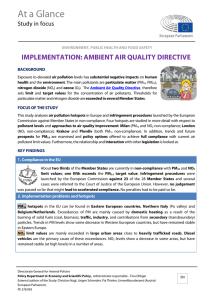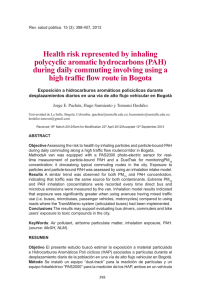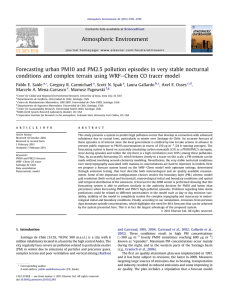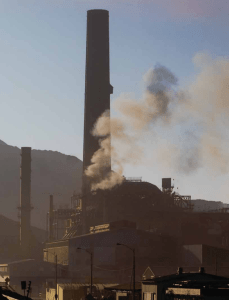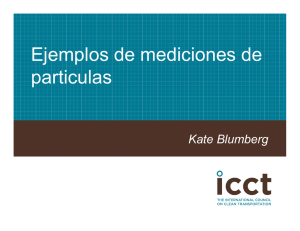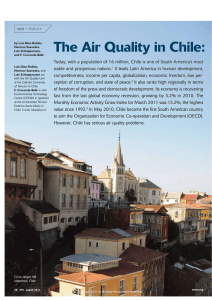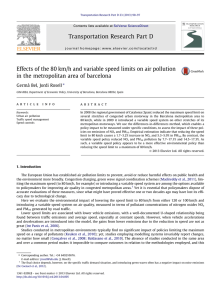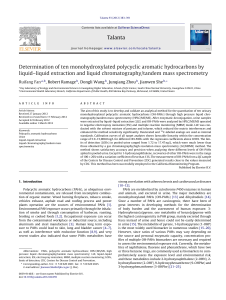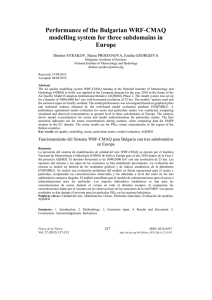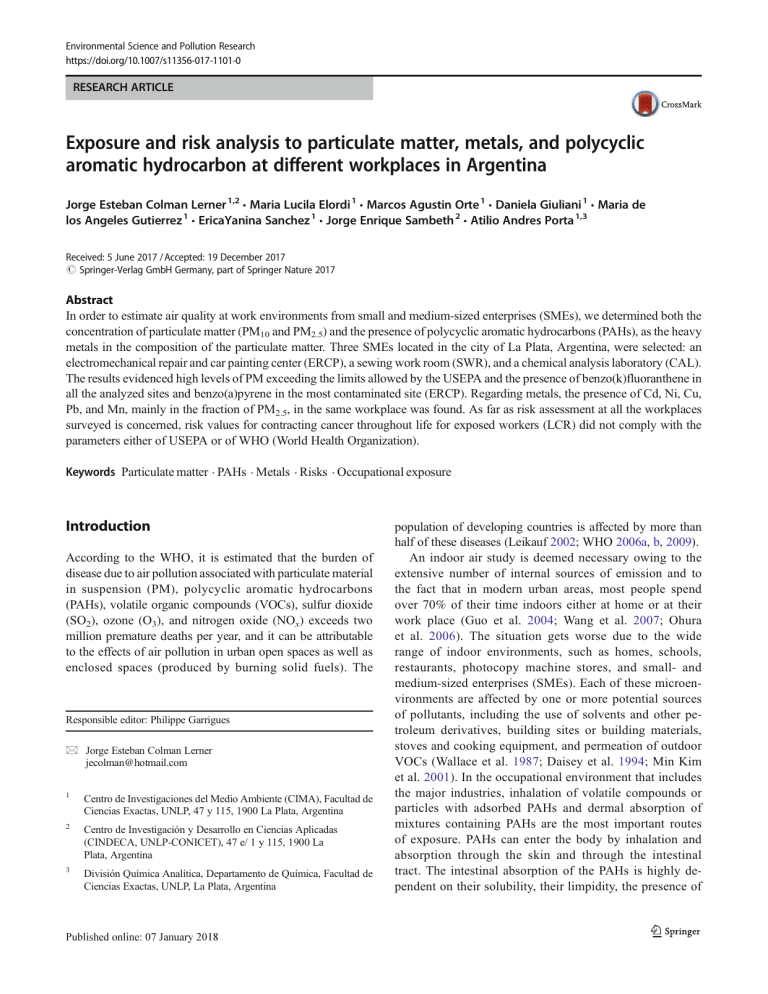
Environmental Science and Pollution Research https://doi.org/10.1007/s11356-017-1101-0 RESEARCH ARTICLE Exposure and risk analysis to particulate matter, metals, and polycyclic aromatic hydrocarbon at different workplaces in Argentina Jorge Esteban Colman Lerner 1,2 & Maria Lucila Elordi 1 & Marcos Agustin Orte 1 & Daniela Giuliani 1 & Maria de los Angeles Gutierrez 1 & EricaYanina Sanchez 1 & Jorge Enrique Sambeth 2 & Atilio Andres Porta 1,3 Received: 5 June 2017 / Accepted: 19 December 2017 # Springer-Verlag GmbH Germany, part of Springer Nature 2017 Abstract In order to estimate air quality at work environments from small and medium-sized enterprises (SMEs), we determined both the concentration of particulate matter (PM10 and PM2.5) and the presence of polycyclic aromatic hydrocarbons (PAHs), as the heavy metals in the composition of the particulate matter. Three SMEs located in the city of La Plata, Argentina, were selected: an electromechanical repair and car painting center (ERCP), a sewing work room (SWR), and a chemical analysis laboratory (CAL). The results evidenced high levels of PM exceeding the limits allowed by the USEPA and the presence of benzo(k)fluoranthene in all the analyzed sites and benzo(a)pyrene in the most contaminated site (ERCP). Regarding metals, the presence of Cd, Ni, Cu, Pb, and Mn, mainly in the fraction of PM2.5, in the same workplace was found. As far as risk assessment at all the workplaces surveyed is concerned, risk values for contracting cancer throughout life for exposed workers (LCR) did not comply with the parameters either of USEPA or of WHO (World Health Organization). Keywords Particulate matter . PAHs . Metals . Risks . Occupational exposure Introduction According to the WHO, it is estimated that the burden of disease due to air pollution associated with particulate material in suspension (PM), polycyclic aromatic hydrocarbons (PAHs), volatile organic compounds (VOCs), sulfur dioxide (SO2), ozone (O3), and nitrogen oxide (NOx) exceeds two million premature deaths per year, and it can be attributable to the effects of air pollution in urban open spaces as well as enclosed spaces (produced by burning solid fuels). The Responsible editor: Philippe Garrigues * Jorge Esteban Colman Lerner [email protected] 1 Centro de Investigaciones del Medio Ambiente (CIMA), Facultad de Ciencias Exactas, UNLP, 47 y 115, 1900 La Plata, Argentina 2 Centro de Investigación y Desarrollo en Ciencias Aplicadas (CINDECA, UNLP-CONICET), 47 e/ 1 y 115, 1900 La Plata, Argentina 3 División Química Analítica, Departamento de Química, Facultad de Ciencias Exactas, UNLP, La Plata, Argentina population of developing countries is affected by more than half of these diseases (Leikauf 2002; WHO 2006a, b, 2009). An indoor air study is deemed necessary owing to the extensive number of internal sources of emission and to the fact that in modern urban areas, most people spend over 70% of their time indoors either at home or at their work place (Guo et al. 2004; Wang et al. 2007; Ohura et al. 2006). The situation gets worse due to the wide range of indoor environments, such as homes, schools, restaurants, photocopy machine stores, and small- and medium-sized enterprises (SMEs). Each of these microenvironments are affected by one or more potential sources of pollutants, including the use of solvents and other petroleum derivatives, building sites or building materials, stoves and cooking equipment, and permeation of outdoor VOCs (Wallace et al. 1987; Daisey et al. 1994; Min Kim et al. 2001). In the occupational environment that includes the major industries, inhalation of volatile compounds or particles with adsorbed PAHs and dermal absorption of mixtures containing PAHs are the most important routes of exposure. PAHs can enter the body by inhalation and absorption through the skin and through the intestinal tract. The intestinal absorption of the PAHs is highly dependent on their solubility, their limpidity, the presence of Environ Sci Pollut Res bile, and the limpidity of the various PAH-containing foods ingested (Unwin et al. 2006). Particulate matter suspended in air produces adverse health effects resulting from exposures recently experienced by urban populations in both developed and developing countries, standing out adverse effects on lung development and function, as well as increased respiratory morbidity, often manifested as a diagnosis of asthma or COPD, and increased mortality, especially in children (Leikauf 2002; Weisel 2002; Massolo 2004; Ostro 2004; Blanco 2008; (IPCS) 2000). Its danger is increased, and because of that, PM can be associated with other pollutants such as polycyclic aromatic hydrocarbons (PAHs) and metals. The former are widespread environmental pollutants, many of which are known as carcinogens associated to PM (Lyall et al. 1988; Nicolaou et al. 1984), like benzo(a)pyrene. Studies on workers exposed to blends containing PAHs have shown an increased risk of lung, skin, bladder, and gastrointestinal cancers (IARC 2015; Lippman and Hawk 2009; Ramesh et al. 2010). Several epidemiological studies (Costa and Dreher 1997; Dye et al. 2001; Kodavanti et al. 2008; Molinelli et al. 2002; Ostro et al. 2007; Rice et al. 2001) support the hypothesis that metals play an important role in the toxicity of particles. Except for iron, all metals (such as Ni, Cd, Pb, Cr, and Mn) associated with particulate matter have anthropogenic origin (Birmili et al. 2006; Mazzei et al. 2008). Shrivastava (2009) reported higher mortality risk from lung cancer in steel industry workers due to exposure to Cr and PAHs. OSHA (Occupational Safety and Health Administration) and NIOSH (National Institute for Occupational Safety and Health) developed exposure limits designed to protect a worker through both acute and chronic exposure scenarios (Table 1). The NIOSH recommended exposure limits (RELs) indicate a timeweighted average (TWA) concentration for up to a 10-h workday during a 40-h workweek. A short-term exposure limit (STEL) is a 15-min TWA exposure that should not be exceeded at any time during a workday. A ceiling REL should not be exceeded at any time. TWA concentrations for OSHA permissible exposure limits (PELs) must not be exceeded during any an 8-h work shift of a 40-h workweek. An additional screening value used to protect workers is the Immediately Dangerous to Life and Health (IDLH) concentration. IDLH exposure conditions are defined as Bconditions that pose an immediate threat to life or health, or conditions that pose an immediate threat of severe exposure to contaminants, such as radioactive materials, which are likely to have adverse cumulative or delayed effects on health.^ The IDLH is considered a maximum concentration above which only a Table 1 Regulatory and recommended exposure limits for PM and some PAHs and metals Substance Regulatory limits Recommended limits OSHA PEL NIOSH REL ppm mg m−3 Particulates – not otherwise regulated (PNOR): total dust Particulates – not otherwise regulated (PNOR): respirable fraction Naphthalene 10 PAHs Manganese Nickel Chromium Lead – – – – – Cal/OSHA PEL 8-h TWA (ST) STELa (C) Ceilingb Up to 10-h TWA (ST) STELa (C) Ceilingb ACGIHc TLV 8-h TWA (ST) STELa (C) Ceilingb 15 10 mg m−3 – – 5 5 mg m−3 – – 50 0.1 ppm 10 ppm (ST) 15 ppm 0.2 15 1 0.5 0.05 – 10 mg m−3 0.5 mg m−3 – – 0.1 mg m−3 – 0.015 mg m−3 – – 10 ppm (ST) 15 ppm 0.2 mg m−3 10 mg m−3 1.5 mg m−3 – – a Short-term exposure limit (STEL) b PEL, REL, or TVL are ceiling values c ACGIH, Association Advancing Occupational and Environmental Health highly reliable breathing apparatus providing maximum worker protection should be permitted (NIOSH 2007). In this study, we determined PM10, PM4, and PM2.5 levels and related compounds (PAHs and metals) at different workplaces (SMEs) as to provide thorough quality assessment of these work environments and evaluated the risk associated with exposure to various pollutants. Experimental section Workplaces studied For this study, three SMEs located in the city of La Plata, Buenos Aires (Colman Lerner et al. 2012), were selected (Fig. 1). These SMEs were an electromechanical repair and car painting center (ERCP, 34° 53′ 28.95″ S and 58° 1′ 46.37″ W), a sewing work room (SWR, 34° 53′ 23.61″ S and 58° 1′ Environ Sci Pollut Res Fig. 1 SMEs located in the city of La Plata, Buenos Aires, Argentina 25.65″ W), and a chemical analysis laboratory (CAL, 34° 54′ 23.86″ S and 57° 56′ 46.02″ W). The ERCP and SWR sites are located in residential areas far from the city center and the CAL site is located in the outer limit of the city of La Plata. Indoor pollutants Particulate matter For sampling PM10 (particles smaller than 10 μm) and PM2.5 (particles smaller than 2.5 μm), a TAS MiniVol TAS portable air sampler equipment was used at a flow rate of 5 L min−1 for 3 days, using polytetrafluoroethylene (PTFE) filters. Samp ling of an intermediate fraction of particulate matter (PM4, particles smaller than 4 μm) was performed by a cyclone aluminum using a PTFE filter, at a rate of 2.5 L min−1 for 5 days. The concentration of PM10, PM4, and PM2.5 in each sample was determined by gravimetric method (Massolo 2004; Massolo et al. 2009; Colman Lerner et al. 2011). Sampling of fractions PM10, PM2.5, and PM4 was performed simultaneously and in triplicate at each site. PAHs For the analysis of PAHs (acenaphthene, acenaphthylene, anthracene, benzo(a)anthracene, benzo(b)fluoranthene, benzo(k)fluoranthene, benzo(ghi)perylene, benzo(a)pyrene, chrysene, dibenz(a, h)anthracene, fluoranthene, fluorene, indeno(1,2,3-cd)pyrene, naphthalene, phenanthrene, and pyrene) on samples of particulate matter (PM10 and PM2.5), the standardized methodology recommended by the National Institute for Occupational Safety and Health (NIOSH) was employed (NIOSH 1998). The extraction of PAHs was performed using 5 mL of acetonitrile (J. Baker, HPLC grade) and an ultrasonic bath (TESTLAB TB10, Power = 400 W, frequency = 40 kHz) for 60 min. Then, the extracts were sieved through 0.22-μm-poresize filters. We proceeded first to determine the recovery factor for each analyte adding a known amount of the 16 PAHs (in triplicate) to unused filters, and then to extract them in the same way as the samples. The extracts were analyzed by ultra-high-performance liquid chromatography (UHPLC Nexera, Shimadzu) with a PDA detector (diode array) and fluorescence. The chromatographic conditions were as follows: column C18 (Zorbax Eclipse PAH 100 mm × 4.6 mm, 3.5 μm) isocratic acetonitrile (40%):water (60%) for 0.66 min, then linear gradient to 100% acetonitrile in 20 min at a rate of 2.0 L min−1. For quantification of the compounds, a wavelength of 220 nm was used with a PDA detector, and for fluorescence, wavelengths of 280 nm (excitation) and 425 nm (emission). We proceeded first to determine the Environ Sci Pollut Res recovery factor (r) for each analyte adding a known amount of PAHs (in triplicate) to unused filters, and then to extract them in the same way as the samples. In Table 2, the detection limits of method (DLM) and r are shown. Metals The analysis of metals (Cd, Pb, Ni, Cu, Mn, and Cr) associated with particulate matter (PM10 and PM2.5) was carried out using atomic absorption spectroscopy (Varian AA-400), with air-acetylene flame, according to NIOSH method 7300 (1994). The filters were digested for metal extraction from the matrix using HNO3 and 30% hydrogen peroxide, in a sand bath heated to 150 °C for 8 h. The resulting solution was filtered (0.45-μm-pore-size filter), bringing it to a final volume of 50.0 mL using deionized water. We proceeded first to determine the r for each analyte adding a known amount of metals (in triplicate) to unused filters, and then to extract them in the same way as the samples. In Table 3, the experimental parameters, r and DLM, are shown. VOCs In this work, we will use the data of VOCs published by Colman Lerner et al. (2012), whose sampling of VOCs was carried out simultaneously in the same monitoring sites (SMEs) of PM. VOC levels mentioned serve to have a full Table 2 understanding of the risks associated with exposure to air pollutants in the workplace. Health risk To estimate the effect on health of metals and PAHs found in PM, we calculated the risk of contracting cancer over a lifetime (LCR) associated with Ni and Cd (both carcinogenic) for the metals and benzo(a)pyrene for the PAHs. LCR was calculated by multiplying the chronic daily intake (CDI) by the power factor (PF), which is 6.1 mg kg−1 day−1 for Cd and 0.84 mg kg−1 day−1 for Ni, and absorption factor (AF), which is 0.90 (Colman Lerner et al. 2014; USEPA 2012; Health Canada 2007; USEPA 2015). LCR ¼ CDI PF AF CDI was calculated according to the following equation: CDI ¼ ðCC IR ED EF LEÞ=ðBW AT NYÞ; where CC is the contaminant concentration (mg m−3); IR, the inhalation flow; ED, the duration of exposure (h week−1); EF, frequency of exposure (weeks year−1); LE, length of exposure; BW, body weight (kg); AT, average time during which they are exposed; and NY, the number of days per year (days). The values obtained for each parameter are the same published by Colman Lerner et al. (2012) for the same studied sites and shown in Table 4. While WHO considered an LCR Levels of PAHs and associated with PM10 and PM2.5 (in ng m−3) Compound ERCP SWR CAL DLM r PM10 PM2.5 PM10 PM2.5 PM10 PM2.5 Naphthalene Acenaphthylene Acenaphthene Fluorene Phenanthrene Anthracene Fluoranthene Pyrene Benzo(a)anthracene Chrysene <DLM <DLM <DLM <DLM <DLM <DLM <DLM 34.8 <DLM <DLM <DLM <DLM <DLM <DLM <DLM <DLM <DLM <DLM <DLM <DLM <DLM <DLM <DLM <DLM <DLM <DLM <DLM <DLM <DLM <DLM <DLM <DLM <DLM <DLM <DLM <DLM <DLM <DLM <DLM <DLM <DLM <DLM <DLM <DLM <DLM <DLM <DLM <DLM <DLM <DLM <DLM <DLM <DLM <DLM <DLM <DLM <DLM <DLM <DLM <DLM 99.1 101.8 110.4 18.2 6.20 10.3 0.34 5.19 0.13 4.22 0.807 0.829 0.919 0.989 0.760 0.594 0.750 0.874 0.915 1.043 Benzo(b)fluoranthene Benzo(k)fluoranthene Benzo(a)pyrene Dibenzo(a, h)anthracene Benzo(ghi)perylene Indeno(1,2,3-cd)pyrene Total PAHs ∑B(a)pequiv <DLM 3.80 3.40 <DLM <DLM <DLM 42.0 3.47 <DLM 2.20 <DLM <DLM <DLM <DLM 2.20 0.02 <DLM 2.00 <DLM <DLM <DLM <DLM 2.00 0.02 <DLM 1.50 <DLM <DLM <DLM <DLM 1.50 0.02 <DLM 3.40 <DLM <DLM <DLM <DLM 3.40 0.03 <DLM 1.00 <DLM <DLM <DLM <DLM 1.00 0.01 0.18 0.13 0.44 1.16 0.70 6.55 0.827 0.927 1.030 0.963 0.845 0.901 Environ Sci Pollut Res Table 3 Experimental parameters, detection limits, and recovery factor for the determination of metals Metal Wavelength Slit (nm) width (nm) Optimum operating range (μg L−1) Lamp current (mA) DLM (μg L−1) Cd 0.02–3.00 4 0.0085 228.8 0.5 Cr 357.9 0.2 0.06–15.0 7 0.0042 Cu Mn 324.7 279.5 0.5 0.2 0.03–10.0 0.02–5.00 4 5 0.0106 0.0127 Ni Pb 232.0 217.0 0.2 1.0 0.10–20.0 0.10–30.0 4 5 0.0106 0.0085 −5 −6 under the range between 1 × 10 and 1 × 10 as Bacceptable,^ USEPA recommended an LCR under 1 × 10−6 (Miller et al. 1999; IPCS 2000). To calculate the LCR for the PAHs, the toxic equivalent of the PAHs found with respect to the benzo(a)pyrene (B(a)Peq), which is the most toxic PAHs, was calculated by the method defined by Nisbet and LaGoy, in 1992. The B(a)Peq is obtained from multiplying the concentration of the compound by the corresponding TEF (toxic equivalency factor), while the sum of BaPeq ( BaPeq) allows knowing the total equivalent toxic concentration of the mixture (Vargas et al. 2013; Nisbet and LaGoy 1992; NEPC 2006; Sosa et al. 2017). The value of TEF for pyrene is 0.001 and 0.01 for benzo(k)fluoranthene. With the value obtained from B(a)Peq, we proceeded to calculate the LCR corresponding to the PAHs (LCRB(a)Peq). The power factor (PF) for benzo(a)pyrene is 3.9 mg kg−1 day−1, that for Ni is 0.84 mg kg −1 day −1 , and that for Cd is 6.1 mg kg−1 day−1 (USEPA 2012; Health Canada 2007; USEPA 2015). Additionally, for a complete assessment of health risk for employees at each workplace, the cumulative cancer risk (CRi) was calculated by summation of the individual compound risks as follows: Table 4 ERCP SWR CAL IR 8.5 8.5 8.5 ED 40 40 40 EF LE 48 8.5 48 27 48 22 BW ATL 70 47 70 47 70 47 NY 240 240 240 samples of PM2.5 by SMEs). For each fraction of particulate matter (PM10, PM4, and PM2.5), the same concentration profile was observed. Higher levels of particulate matter were found at ERCP, doubling the levels at CAL and tripling the levels at SWR. In particular, the concentration ranges for PM10, PM4, and PM2.5 were 550–1500, 400–1100, and 150– 400 μg m−3, respectively. Other studies showed that levels of PM2.5 at offices in Mexico ranged between 70 and 140 μg m −3 (TovalinAhumada et al. 2007), while Chao and Wong (2002) reported levels of PM10 and PM2.5 in Hong Kong households to be 69.5 and 47.0 μg m−3, respectively. Castro et al. (2011) studied the influence of tobacco smokes on the levels of the indoor particle matter at homes in Portugal obtaining values of 66.1 and 57.2 μg m−3 at smoker households and values of 18.6 and 14.5 μg m−3 at smoking-free homes, for PM10 and PM2.5, respectively. A similar study was conducted by Gemenetzis et al. (2006) which analyzed levels of PM10 and PM2.5 at smoker offices and at smoking-free offices in Greece and determined levels of 67.0 μg m−3 for PM2.5 and 93.0 μg m−3 for PM10 at smoking-free offices, while at smoker-office, PM2.5 and PM10 levels increased by obtaining 111 and 139 μg m−3, respectively. Owoade et al. (2009) report levels of PM10 from 86 to 8765 μg m−3 in a scrap iron and steel smelting industry, and CRI ¼ ∑ LCRij ; 1600 j -3 1200 gm Indoor pollutants Particulate matter 1511 1400 where LCRij is the estimated lifetime cancer risk for the chemical j (VOCs, PAHs, and metal associated with PM10 and PM2.5) at each workplace i (Miller et al. 1999). Results and discussion Variables used to calculate the LCR 1000 ERCP CAL SWR 1111 857 800 559 600 567 397 400 417 212 200 0 PM10 PM4 PM2.5 −3 Figure 2 shows values of particulate matter sampled at SMEs (three samples of PM10, three samples of PM4, and three 143 Fig. 2 Particulate matter levels in SMEs (in μg m ). α is USEPA PEL for exposure of 24 h for PM10; β is USEPA PEL for exposure of 24 h for PM2.5 Environ Sci Pollut Res Pal Singh et al. (2013) reported an average suspended particulate matter of about 24.8 mg m−3 among steel workers. In Portugal, Viegas et al. (2014) report values of 149 μg m−3 for PM10 and 108 μg m−3 for PM in waste treatment plants. The Occupational Safety and Health Administration (OSHA) of the U.S. Department of Label has established an 8-h timeweighted average (TWA) limit of 15 mg m−3, measured as total particulate, and the 5-mg-m−3 limit for respirable particulates. These two limits apply to all not-otherwise-regulated particulates (i.e., to those irritants that are not specifically identified in the OSHA’s tables). The American Conference of Governmental Industrial Hygienists (ACGIH) has established a Bthreshold limit value^ (TLV) for an 8-h TWA of 4 mg m−3 total grain dust (wheat, oats, barley) since 1980. The limits adopted in the Argentine legislation are taken from those established by the ACGIH. The Ad Hoc Committee on Grain Dust of the Canadian Thoracic Society Standards Committee considered a Bpermissible exposure level^ (PEL) of 5 mg m−3 advisable to control shortterm effects, even if these effects are transient. Several years ago, also, the Mine Safety and Health Administration (MSHA) proposed changing the metal/nonmetal dust limit from a 10-mg-m−3 total nuisance dust standard to a 5-mg-m−3 respirable dust standard; for USEPA, allowable levels for exposure of 24 h are of 150 μg m−3 for PM10 and of 35 μg m−3 for PM2.5 at the workplace (OSHA 2015; USEPA 2006; Donham et al. 2002). Considering all these values of particulate matter, levels found at SMEs are above (USEPA) or below (OSHA) limits, depending on the organization criteria adopted. PAHs Filters containing particulate matter (PM10 and PM2.5) were analyzed identifying for the level of PAHs (Table 2). Benzo(k)fluoranthene was found in all the samples, being its level always higher in PM10 fraction than PM2.5. Pyrene (34.8 ng m−3) and benzo(a)pyrene (3.40 ng m−3) were found at the ERCPC in PM10 fraction. The presence of benzo(a)pyrene is of outmost importance due to its carcinogenic effects on humans (group 1 on the IARC classification). In general, for the rest of Table 5 Metal Pb Cd Ni Cu Mn Cr the compounds, the levels found were lower than DLM. The NIOSH recommended exposure limit (REL), based on risk evaluations using human or animal health effects data, and on an assessment of what levels can be feasibly achieved by engineering controls and measured by analytical techniques, for benzo(a)pyrene and pyrene is the 0.1 mg m−3, and PEL for the OSHA is the 0.2 mg m−3, so the levels found are several orders of magnitude below those recommended by the NIOSH and OSHA. The values found are consistent with the ones recorded in literature (Liaud et al. 2014; Slezakova et al. 2009), for PAHs, showing values between 0.50 and 290.0 ng m−3 for PM2.5 and between 0.80 and 300.0 ng m−3 for PM10. Specifically, the compound levels for PM2.5 found in this study are comparable or smaller with levels found by similar studies ranging from 0.057 to 12.7 ng m −3 for pyrene, 0.032 to 1.36 ng m −3 for benzo(k)fluoranthene, and 0.072 to 8.38 ng m −3 for benzo(a)pyrene. Lin et al. (2008) found levels of total PAHs around 7420–30,400 ng m−3, in sintering plants (sinter plants agglomerate iron ore fine dust with other fine materials at high temperature, to create a product that can be used in a blast furnace), exceeding by several orders of magnitude those found in this study. Tsai et al. (2001) analyzed the levels of PAH associated with PM in carbon black manufacturing industry, finding levels of benzo(a)pyrene from 0.027 to 77 ng m−3 and those of pyrene from 98.5 to 241 ng m−3, being values similar or superior to those found in this work. The difference in PAH levels found in the ERCP, with respect to the other work environments studied, can be attributed to the work that is performed in the ERCP, which differ from those carried out in the textile workshop (SWR) and the chemical analysis laboratory (CAL). In the workshop (ERCP), works with metals, fuels, metal rolling, and heat treatment of metal parts increase the possibility of finding PAHs associated with the particulate material (mainly in PM10). Metals Table 5 shows metal levels associated with particulate matter for both fractions (PM10 and PM2.5) at the different work environments. The sample with the highest metal content Levels of metals (μg m−3) associated with particulate matter (PM10 and PM2,5) ERCP SWR CAL Literature PM10 PM2.5 PM10 PM2.5 PM10 PM2.5 PM10 PM2.5 < 0.118 0.860 < 0.047 < 0.118 < 0.023 < 0.094 0.097 0.737 0.400 0.057 0.199 < 0.0994 0.055 0.069 < 0.047 < 0.063 0.031 < 0.094 0.074 0.075 < 0.047 < 0.084 < 0.023 < 0.094 0.265 < 0.081 < 0.047 0.952 < 0.023 < 0.094 < 0.118 0.481 < 0.047 < 0.094 < 0.023 < 0.094 0.074–0.249 0.008–0.041 0.002–0.024 0.019–0.043 0.017–0.049 0.032–0.040 0.060–0.233 0.008–0.032 0.002–0.023 0.011–0.038 0.011–0.035 0.023–0.035 Environ Sci Pollut Res Table 6 Lifetime cancer risk (LCR) and cumulative cancer risk (CR) in the different workplaces ERCP LCRNi LCRCd LCRB(a)pequiv LCRbenzene LCRTrichloroethylene LCRchloroform CRij(PAHs + metals) CRij(total) SWR CAL PM10 PM2.5 PM10 PM2.5 PM10 PM2.5 < 6.24 × 10−06 8.36 × 10−04 2.14 × 10−06 1.44 × 10−04 2.50 × 10−04 6.80 × 10−04 8.34 × 10−04 1.91 × 10−03 5.31 × 10−05 7.11 × 10−04 1.36 × 10−08 < 1.65 × 10−05 1.76 × 10−04 3.92 × 10−08 < 2.43 × 10−06 < 3.20 × 10−06 < 1.88 × 10−05 1.76 × 10−04 1.76 × 10−04 < 1.65 × 10−05 1.91 × 10−04 2.94 × 10−08 < 1.98 × 10−05 < 2.48 × 10−04 5.55 × 10−08 8.71 × 10−05 6.53 × 10−06 2.86 × 10−03 5.55 × 10−08 2.95 × 10−03 < 1.98 × 10−05 1.47 × 10−03 1.63 × 10−08 7.64 × 10−04 1.84 × 10−03 corresponds to the ERCP (PM2.5), tracing the presence of almost all sought metals, except Cr. In general, the metals appearing most frequently have been traced as follows: Cd > Pb > Cu = Mn > Ni (Birmili et al. 2006; Mazzei et al. 2008). In general, metal levels (except those of Ni and Cd) at the workplaces studied are consistent with the values found in literature (Chao and Wong 2002; Gemenetzis et al. 2006; Wang et al. 2006) as shown in Table 5. Particularly, the ERCP presents levels of Cd associated with PM10 and PM2.5 higher than the ones recorded in literature, likewise for Ni and Mn but only for PM2.5. Higher values of Cd and Ni were found associated with the PM2.5 in the CAL, with respect to those described by other studies. Mousavian et al. (2017) studied the levels of heavy metals in metallurgical industrial complex (like the workplace ERCP) and found mean levels of Pb, Cr, Ni, and Cd as 45, 40, 23, and 1.5 μg m−3, respectively, exceeding the levels found in this work. Health risk Analyzing the risk associated with PAHs, only the LCRB(a)Peq value associated with ERCP PM10 (2.14 × 10−06) exceeds the USEPA limit value. In contrast, in all the studied SMEs (except for CAL PM10), the value of LCR for Cd (associated with PM10 and PM2.5) exceed values of the USEPA and WHO in all the studied SMEs (except for CAL PM10), (Table 6). Taking into account PAHs and metals, the cumulative risk (CRPAHs + metals) exceeds WHO guideline values and those of the USEPA, for all the three sites regarding PM2.5. To comprehensively assess air quality at workplaces, it is necessary to take into account VOC levels. Some of them are carcinogenic or possibly carcinogenic according to IARC classification (groups 1 and 2B). Colman Lerner et al. (2012) found in the same workplaces presented in this study, VOC levels were much higher in several orders of magnitude. Particularly, this was observed in chloroform, carbon tetrachloride, toluene, and xylenes at the ERCP than at the other 1.91 × 10−04 1.91 × 10−04 1.47 × 10−03 4.42 × 10−03 sampled workplaces. This is within the expected outcome since its everyday activities involve use of organic solvents for the cleaning and painting of mechanical parts. A similar situation was observed at the CAL, where chloride compounds are specially used as universal solvents for many pre-treatments of samples and analysis. The results showed LCRs at the ERCP (Table 6) between one and two orders of magnitude higher than that at the CAL for benzene and trichloroethylene, respectively; for chloroform, the value of LCR at the CAL was an order of magnitude higher than the LCR at the ERCP and two orders of magnitude higher than at SWR. It should be noticed that, when considering VOCs, PAHs, and metals, the risk of contracting cancer (CRtotal) obtained at each workplace studied exceeds the reference values (Table 6) of the USEPA (1 × 10−6) and WHO (1 × 10−5–1 × 10−6). Those risk values are comparable for the ERCP and CAL (same order of magnitude). As for the SWR, shall risk due to the contribution of VOCs be considered individually, this would comply with the parameters of both organizations, but the estimation of risk, taking into account metals and PAHs, exceeds the reference values; therefore, the need for risk estimates, taking into account several possible contaminants, becomes evident, for an estimate of the real risk to which the workers are exposed. Conclusions Industrial workers may be exposed to high concentrations of particulate matter (PM) that has adverse health effects (as well as VOCs). Its danger is increased, owing to the fact that PM may be associated with other pollutants such as PAHs and metals. To characterize the quality of regional work environments at small and medium-sized enterprises, three SMEs located in the city of La Plata, Argentina, were selected for this study: an Environ Sci Pollut Res electromechanical repair and car painting center (ERCPC), a sewing work room (SWR), and a chemical analysis laboratory (CAL). At these SMEs, the concentration of particulate matter (PM10 and PM2.5) was determined, and the content of polycyclic aromatic hydrocarbons and heavy metals associated with the particulate matter was analyzed. In reference to values of particulate matter sampled at SMEs for each fraction of particulate matter (PM10, PM4, and PM2.5), the same concentration profile was observed. Higher levels of particulate matter were found at the ERCPC, doubling the levels at the CAL and tripling the levels at the SWR. These levels are among the highest values reported by literature and are above (USEPA) or below (OSHA) limits, depending on the organization criteria adopted. The analysis of particle-bound PAHs revealed that benzo(k)fluoranthene was found in all the samples, being its level always higher in the PM10 fraction than PM2.5. Pyrene and benzo(a)pyrene were found at the ERCPC for PM10 fraction and the presence of benzo(a)pyrene is of outmost importance due to its carcinogenic effects on humans (group 1 on the IARC classification). In general, for the rest of the compounds, the levels found were lower than DLM. The values found are consistent with the ones recorded in literature and lower than the limit values of the NIOSH and OSHA. In relation to metals associated with PM, the sample with the highest metal content corresponds also to the ERCPC (fundamentally on PM2.5). In general, the metals which appeared most frequently have been traced as follows: Cd > Pb > Cu = Mn > Ni. To estimate health effect, the risk of contracting cancer over a lifetime (LCR) associated with Ni and Cd and PAHs was calculated. Furthermore, for complete risk assessment of employees’ health at each workplace, the cumulative cancer risk (CR) was calculated by summation of the individual compound risks of metals (Ni and Cd) and PAHs. It is worth mentioning that the risk of contracting cancer, considering PAHs and metals (CRPAHs + metals) traced at each workplace, exceeded the reference values of the USEPA (1 × 10−6) and WHO (1 × 10−5–1 × 10−6), and CR values obtained were comparable for the ERCP and CAL (same order of magnitude). As for the SWR, shall analyze risk deriving from contribution of VOCs in isolation (from previous studies), this would comply with the parameters of both organizations; yet, risk estimation with metals and PAHs associated at PM (PM10 and PM2.5) plus VOCs (CRtotal) exceeds the reference values. Therefore, the need for risk estimates taking into account several possible contaminants is important to establish the true risk to which workers are exposed. Finally, some limitations were found in this study. The highlight among them is the lack of cooperation of small companies with respect to allowing the monitoring of pollutants, as well as the lack of supervision from the control organisms. Among the future perspectives we can highlight is a quality leap in the monitoring particulate material and VOCs (greater sensitivity of the analysis equipment, higher temporal resolution of the sampling techniques) which allows us to study a greater number of workplaces for the same monitoring period. Acknowledgments The authors would like to thank the Universidad Nacional de La Plata (UNLP), the Consejo Nacional de Investigaciones Científicas y Técnicas (CONICET), and the Comisión de Investigaciones Científicas de la Provincia de Buenos Aires (CIC) for their financial support to the present study. References Blanco ER (2008) Variables e indicadores de gestión en el marco de políticas públicas. La contaminación atmosférica y la salud de la población en la Micro región La Plata, Berisso y Ensenada. Approved Master’s Thesis on Environmental Management for Urban Development, Faculty of Architecture, Urbanism and Design, UNMdP. Director A. Porta Birmili W, Allen AG, Bary F, Harrison RM (2006) Trace metal concentrations and water solubility in size-fractionated atmospheric particles and influence of road traffic. Environ Sci Technol 40(4):1144– 1153. https://doi.org/10.1021/es0486925 Castro D, Slezakova K, Delerue-Matos C, Alvim-Ferraz M, Morais S, Pereira M (2011) Polycyclic aromatic hydrocarbons in gas and particulate phases of indoor environments influenced by tobacco smoke: levels, phase distributions, and health risks. Atmos Environ 45(10):1799–1808. https://doi.org/10.1016/j.atmosenv. 2011.01.018 Chao CY, Wong KK (2002) Residential indoor PM10 and PM2.5 in Hong Kong and the elemental composition. Atmos Environ 36(2): 265–277. https://doi.org/10.1016/S1352-2310(01)00411-3 Colman Lerner JE., Morales A., Aguilar M., Barrionuevo P., Ditondo J., Porta A., Massolo L., Dodero VI, (2011). Calidad del aire en áreas urbanas e industriales en la Provincia de Buenos Aires. Estudio comparativo entre La Plata Y Bahía Blanca. Contributions from the III Annual Meeting PROIMCA. Editors: E. Puliafito & N. Quaranta. UTN, Buenos Aires. pp 191–200 Colman Lerner JE, Sanchez EY, Sambeth JE, Porta AA (2012) Characterization and health risk assessment of VOCs in occupational environments in Buenos Aires, Argentina. Atmos Environ 55: 440–447. https://doi.org/10.1016/j.atmosenv.2012.03.041 Colman Lerner JE, Kohajda T, Aguilar ME, Massolo LA, Sanchez EY, Porta AA, Optiz P, Wichmann G, Herbarth O, Mueller A (2014) Improvement of health risk factors after reduction of VOC concentrations in industrial and urban areas. Environ Sci Pollut Res 21(16): 9676–9688. https://doi.org/10.1007/s11356-014-2904-x Costa DL, Dreher KL (1997) Bioavailable transition metals in particulate matter mediate cardiopulmonary injury in healthy and compromised animal models. Environ Health Perspect 105(Suppl. 5):1053–1060. https://doi.org/10.1289/ehp.97105s51053 Daisey JM, Hodgson AT, Fisk WJ, Mendell MJ, Ten Brinke J (1994) Volatile organic compounds in twelve California office buildings: classes, concentrations and sources. Atmos Environ 28(22):3557– 3562. https://doi.org/10.1016/1352-2310(94)00200-5 Donham K.J., Thorne P.S., Breuer G.M., Powers W., Marquez S., Reynols S.J., (2002). Chapter 8. Exposure limits related to air quality and risk assessment. Concentrated Animal Feeding Operations Air Quality Study. Iowa State University and the University of Iowa Study Group. https://www.public-health.uiowa.edu/ehsrc/ CAFOstudy.htm Environ Sci Pollut Res Dye JA, Lehmann JR, McGee JK, Winsett DW, Ledbetter AD, Everitt JI, Ghio AJ, Costa DL (2001) Acute pulmonary toxicity of particulate matter filter extracts in rats: coherence with epidemiologic studies in Utah Valley residents. Environ. Health Perspect 109(Suppl):395– 403 Gemenetzis P, Moussas P, Arditsoglou A, Samar C (2006) Mass concentration and elemental composition of indoor PM2.5 and PM10 in University rooms in Thessaloniki, northern Greece. Atmos Environ 40(17):3195–3206. https://doi.org/10.1016/j.atmosenv.2006.01.049 Guo H, Lee SC, Chan LY, Li WM (2004) Risk assessment of exposure to volatile organic compounds in different indoor environments. Environ Res 94(1):57–66. https://doi.org/10.1016/S0013-9351(03) 00035-5 Health Canada, (2007). Slope factors for carcinogens from Health Canada. Available on http://www.popstoolkit.com/tools/HHRA/ SF_HealthCanada.aspx International Agency for Research on Cancer, 2015. IARC monographs on the evaluation of carcinogenic risk of chemicals to humans. Supplement No. 7. Overall evaluations of carcinogenicity: an updating of IARC monographs volumes 1 to 42. Lyon: International Agency for Research on Cancer; 1987. http:// monographs.iarc.fr/ENG/Monographs/suppl7/ [Accessed on 20th January, 2015] International Programme on chemical safety (IPCS), (2000). Environmental health criteria 214: human exposure assessment. World Health Organization, Geneve. Available on http://www. inchem.org/documents/ehc/ehc/ehc214.htm Kodavanti UP, Schladweiler MC, Gilmour PS, Wallenborn JG, Mandavilli BS, Ledbetter AD, Christiani DC, Runge MS, Karoly ED, Costa DL, Peddada S, Jaskot R, Richards JH, Thomas R, Madamanchi NR, Nyska A (2008) The role of particulate matterassociated zinc in cardiac injury in rats. Environ Health Perspect 116(1):13–20. https://doi.org/10.1289/ehp.10379 Leikauf GD (2002) Hazardous air pollutants and asthma. Environmental Health Perspectives 110(Supplement 4):505–526 Liaud C, Dintzer T, Tschamber V, Trouve G, Le Calvé S (2014) Particlebound PAHs quantification using a 3-stages cascade impactor. Environ Pollut 195:64–72. https://doi.org/10.1016/j.envpol.2014. 08.007 Lin YC, Lee WJ, Chend SJ, Chang-Chien GP, Tsai PJ (2008) Characterization of PAHs exposure in workplace atmospheres of a sinter plant and health-risk assessment for sintering workers. Journal of Hazardous Materials 158:636–643 Lippman SM, Hawk ET (2009) Cancer prevention: from 1727 to milestones of the past 100 years. Cancer Res 69(13):5269–5284. https:// doi.org/10.1158/0008-5472.CAN-09-1750 Lyall RJ, Hooper MA, Mainwaring SJ (1988) Polycyclic aromatic hydrocarbons in the Latrobe valley. Atmos Environ 22(11):2549–2555. https://doi.org/10.1016/0004-6981(88)90487-8 Massolo L, (2004). Exposición a contaminantes atmosféricos y factores de riesgo asociados a la calidad de aire en La Plata y alrededores. Approved Doctoral Thesis, Faculty of Exact Sciences, UNLP. Directors: A. Ronco and A. Porta Massolo L; Müller A; Rehwagen M; Porta A, Herbarth, O; A. Ronco, (2009). Estimación del riesgo asociado a PAHs en ambientes urbanos e industriales. Contaminación Atmosférica en Argentina. Contribuciones de la II Reunión Anual PROIMCA. Editores: E. Puliafito & N. Quaranta. UTN, Buenos Aires. pp 45–54 Mazzei F, D’Alessandro A, Lucarelli F, Nava S, Prati P, Valli G, Vecchi R (2008) Characterization of particulate matter sources in an urban environment. Sci Total Environ 401(1-3):81–89. https://doi.org/10. 1016/j.scitotenv.2008.03.008 Miller, G., Fortney, P., Lantos, T., Thompson, M., Pelosi, N., Eshoo, A., Lee, B., Woolsey, L, (1999). Exposure to hazardous air pollutants in the San Francisco Bay area Available on http://georgemiller.house. gov/airreport.html Min Kim Y, Harrad S, Harrison RM (2001) Concentrations and sources of VOCs in urban domestic and public microenvironments. Environ Sci Technol 35(6):997–1004. https://doi.org/10.1021/es000192y Molinelli AR, Madden MC, McGee JK, Stonehuerner JG, Ghio AJ (2002) Effect of metal removal on the toxicity of airborne particulate matter from the Utah Valley. Inhal Toxicol 14(10):1069–1086. https://doi.org/10.1080/08958370290084737 Mousavian NA, Mansouri N, Nezhadkurki F (2017) Estimation of heavy metal exposure in workplace and health risk exposure assessment in steel industries in Iran. Measurement 102:286–290 NEPC, 2006. National Environment Protection Council. National Environment Protection (National Pollutant Inventory) measure. Technical advisory panel. Final report to the National Environment Protection Council. http://www.scew.gov.au/sites/. www.scew.gov. au/files/resources/759262ce-2dcd-0b74-6d3d-7605f819cd07/files/ npi-rpt-technical-advisory-panel-final-report-final-200606.pdf Nicolaou K, Masclet P, Mouvier G (1984) Sources and chemical reactivity of polynuclear aromatic hydrocarbons in the atmosphere—a critical review. Sci Total Environ 32(2):103–132. https://doi.org/10. 1016/0048-9697(84)90125-6 NIOSH (1994) Method 7300: elements by ICP. NIOSH manual of analytical methods (NMAM), Fourth Edition. Issue 2 NIOSH (1998) Method 5506: polynuclear aromatic hydrocarbons by HPLC. NIOSH manual of analytical methods (NMAM), Fourth Edition NIOSH, (National Institute for Occupational Safety and Health) (2007) NIOSH pocket guide to chemical hazards. 2005-149. Department of Health and Human Services, Center for Disease Control and Prevention Nisbet I, LaGoy P (1992) Toxic equivalency factors (TEFs) for polycyclic aromatic hydrocarbons (PAHs). Regul Toxicol Pharmacol 16: 290e300 Ohura T, Amagai T, Senga Y, Fusaya M (2006) Organic air pollutants inside and outside residences in Shimizu, Japan: levels, sources and risks. Sci Total Environ 366(2-3):485–499. https://doi.org/10.1016/ j.scitotenv.2005.10.005 OSHA (Occupatinal Safety and Health Standards) Standard-29 CFR. (2015). Available on http://www.osha.gov/pls/oshaweb/owastand. display_standard_group?p_toc_level=1&p_part_number=1910 Ostro B, (2004). Outdoor air pollution. Assessing the environmental burden of disease at national and local levels. Environmental Burden of Diseases Series No 5. World Health Organization. Protection of the Human Environment. Geneva Ostro B, Feng WY, Broadwin R, Green S, Lipsett M (2007) The effects of components of fine particulate air pollution on mortality in California: results from CALFINE. Environ Health Perspect 115(1):13–19 Owoade OK, Olise FS, Obioh IB, Olaniyi HB, Ferrero L, Bolzacchini E (2009) EDXRF elemental assay of airborne particulates: a case study of an iron and steel smelting industry, Lagos, Nigeria. Sci Res Essay 4(11):1342–1347 available online at <http://www. academicjournals.org/article/article1380627511_Owoade%20et% 20al.pdf> Ramesh A, Archibong AE, Niaz MS (2010) Ovarian susceptibility to benzo[a]pyrene: tissue burden of metabolites and DNA adducts in F-344 rats. J Toxicol Environ Health A 73(23):1611–1625. https:// doi.org/10.1080/15287394.2010.514225 Rice TM, Clarke RW, Godleski JJ, Al-Mutairi E, Jiang NF, Hauser R, Paulauskis JD (2001) Differential ability of transition metals to induce pulmonary inflammation. Toxicol Appl Pharmacol 177(1):46– 53. https://doi.org/10.1006/taap.2001.9287 Pal Singh L., Bhardwaj A., Kumar Deepa K., 2013. Occupational exposure to respirable suspended particulate matter and lung functions deterioration of steel workers: an exploratory study in India, ISRN Public Health, (1–8). Available online at: <http://www.hindawi. com/journals/isrn/2013/325410/> Environ Sci Pollut Res Shrivastava, A.K. (2009). Health hazards of foundries and forges, in the 57th Indian Foundry Congress at Science, Kolkata 13th–15th February 2009, India. <http://foundryinfo-India.org/images/pdf/ 57ifctp8.pdf> Sosa BS, Porta AA, Colman Lerner JE, Banda Noriega R, Massolo L (2017) Human health risk due to variations in PM10-PM2.5 and associated PAHs levels. Atmos Environ 160:27e35 Slezakova K, Castro D, Pereira MC, Morais S, Delerue-Matos C, AlvimFerraz MC (2009) Influence of tobacco smoke on carcinogenic PAH composition in indoor PM10 and PM2.5. Atmos Environ 43(40): 6376–6382. https://doi.org/10.1016/j.atmosenv.2009.09.015 Tovalin-Ahumada H, Whitehead L, Blanco S (2007) Personal exposure to PM2.5 and element composition—a comparison between outdoor and indoor workers from two Mexican cities. Atmos Environ 41(35):7401–7413. https://doi.org/10.1016/j.atmosenv.2007.05.059 Tsai P, Shieh H, Lee W, Lai S (2001) Characteristics of exposure profiles for workers exposed to airborne dusts and polycyclic aromatic hydrocarbons (PAHs) in the carbon black manufacturing industry. J Occup Health 43(3):118–128. https://doi.org/10.1539/joh.43.118 Unwin J, Cocker J, Scobbie E, Chambers H (2006) An assessment of occupational exposure to polycyclic aromatic hydrocarbons in the UK. Ann Occup Hyg:1–9 USEPA, (2006). Federal register Vol. 71, No. 200. Rules and regulations. Available on http://www.epa.gov/air/criteria.html USEPA, (2012). Risk characterization, chapter 8: risk assessment guidance for superfund volume I human health evaluation manual. (Part A 291 pp. 6.33 MB). Risk Assessment Guidance for Superfund (RAGS) Part A. Interim final (RAGS Part A), EPA/540/1-89/002. United States Environmental Protection Agency. Waste and Cleanup Risk Assessment. Human Health: Exposure Assessment. Risk Assessment Guidance for Superfund (RAGS). Available on http:// www.epa.gov/oswer/ riskassessment/ragsa/ USEPA. Integrated Risk Information System (IRIS). (2015). Available on http://www.epa.gov/iris/ Vargas M, Romero G, Palencia A, Rivero E, Piñero S (2013) Toxic equivalency factors of polycyclic aromatic hydrocarbons (PAHS) in Valencia, Venezuela. Acta Toxicologica Argenina 21:69e77 Viegas S, Almeida-Silva M, Viegas C (2014) Occupational exposure to particulate matter in 2 Portuguese waste-sorting units. Int J Occup Med Environ Health 27(5):854–862. https://doi.org/10.2478/ s13382-014-0310-8 Wallace LA, Pellizzari E, Leaderer B, Zelon H, Sheldon L (1987) Emissions of volatile organic compounds from building materials and consumer products. Atmos Envir 21(2):385–393. https://doi. org/10.1016/0004-6981(87)90017-5 Wang X, Bi X, Sheng G, Fu J (2006) Hospital indoor PM10/PM2.5 and associated trace elements in Guangzhou, China. Sci Total Environ 366(1):124–135. https://doi.org/10.1016/j.scitotenv.2005.09.004 Wang S, Ang HM, Tade MO (2007) Volatile organic compounds in indoor environment and photocatalytic oxidation: state of the art. Environ Int 33(5):694–705. https://doi.org/10.1016/j.envint.2007. 02.011 Weisel CP (2002) Assessing exposure to air toxics relative to asthma. Environmental Health Perspectives 110(Supp. 4):527–537 World Health Organization, (2006a). Guías de calidad del aire de la OMS relativas al material particulado, el ozono, el dióxido de nitrógeno y el dióxido de azufre. Actualización mundial 2005. WHO/SDE/PHE/ OEH/06.02, OMS. Available on http://whqlibdoc.who.int/hq/2006/ WHO_SDE_PHE_ OEH_06.02_spa.pdf World Health Organization, (2006b). Environmental health criteria 237. Principles for evaluating health risks in children associated with exposure to chemicals. Published under the joint sponsorship of the United Nations Environment Programme, the International Labour Organization and the World Health Organization, Geneva World Health Organization, (2009). Environmental health criteria 239. Principles for modelling dose–response for the risk assessment of chemicals. Published under the joint sponsorship of the United Nations Environment Programme, the International Labour Organization and the World Health Organization, Geneva

